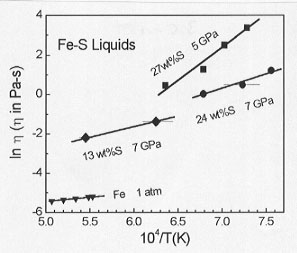

The liquid outer core contains Fe-Ni alloyed with one or more light elements (S, Si, O, H, C,...). It is accepted that the motion of the outer core fluid is responsible for the generation and maintenance of the geomagnetic field. One of the most important physical properties controlling the motion of the Fe alloy fluid is viscosity. Some geodynamo model calculations necessarily employ viscosity values as high as 107 Pa s for the outer core, despite being inconsistent with the often quoted value of 10-2 Pa s derived from liquid metal theory. These high viscosities reflect the need to reduce the computational complexities associated with small scale patterns of fluid flow in a low viscosity system. Even with high viscosity values, very realistic features of the geomagnetic field and its temporal evolution, including polarity reversals, have been modelled. While the superposed effects of internal friction and motion of the fluid, characterized by molecular and eddy viscosities, respectively, are undoubtedly at play in the outer core, we must first understand the effects of temperature, pressure, and composition on the molecular viscosity before we can determine the effective viscosity in the outer core. The experimental approach involves measurement of the P- and T-dependences of viscosities of Fe-S liquids with varying sulfur content (13-27 wt% S) at pressures up to 7 GPa and temperatures up to 1600°C. The electro-detection method of in-situ speedometry of sapphire spheres was carried out in multianvil apparatus using 25 mm octahedral cell assemblies. The results plotted below (Fig. 3.5-1) suggest that an increase in S content causes an increase in alloy viscosity as compared with 1 atm results on pure liquid Fe at 1 atm. Moreover, the effect of increasing S content increases the activation energy of viscous flow.
 |
Fig. 3.5-1: The dynamic viscosity of Fe-S liquids of varying S content as a function of inverse temperature. |

Tel: +49-(0) 921 55 3700 / 3766, Fax: +49-(0) 921 55 3769, E-mail: bayerisches.geoinstitut(at)uni-bayreuth.de
 Previous page
Previous page